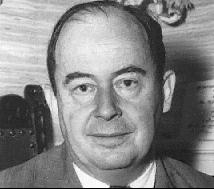 Born in Budapest, Hungary in 1903.
Born in Budapest, Hungary in 1903.
After simultaneously earning a doctorate in mathematics from the University of Budapest and a doctorate in chemistry from the University of Zurich, John von Neumann joined the faculty of the University of Berlin in 1927. He moved to Princeton in 1932 where he became the youngest member of the IAS. During this time, he made important contributions not only to pure and applied mathematics, but also to physics and, in some ways, philosophy (esp. in relation to the quantum paradox). He was also active in the Manhattan Project (the development of the atomic bomb) and was one of President Truman’s advisors on the Atomic Energy Commission. His later work on parallel processes and networks has earned him the label of the ‘father of the modern computer’. As Nicholas Kaldor would later write, “He was unquestionably the nearest thing to a genius I have ever encountered.”
An astoundingly creative mathematician, John von Neumann has played a rather important role in post-war economic theory through two essential pieces of work: his 1937 paper on a multi-sectoral growth model and his 1944 book (with Oskar Morgenstern) on game theory and uncertainty.
John von Neumann’s famous 1937 paper, initially written under the auspices of the famous ‘Vienna Colloquium’ and derived from his reading of Knut Wicksell and Gustav Cassel, has been called “the greatest paper in mathematical economics that was ever written” (E. Roy Weintraub, 1983). It precipitated what Morishima later called a veritable ‘von Neumann Revolution’ in general equilibrium, capital and growth theory. He introduced several important concepts in his 1937 paper, besides the obvious methodological one of resurrecting ‘mathematical economics’. He bequeathed:
(1) the concept of ‘activity analysis’ production sets, to be later extensively employed by Koopmans and the Neo-Walrasians;
(2) linear system of reproduction as later used and developed by Wassily Leontief, Piero Sraffa and the Neo-Ricardians;
(3) price-cost and demand-supply inequalities which accounted for the Vienna Critique of Walrasian systems of equations;
(4) the first use of a (generalization) of L.E.J. Brouwer’s fixed- point theorem to prove the existence of an equilibrium, later to be known as Kakutani’s Fixed Point Theorem;
(5) The minimax and maximin solution methods and the saddelpoint characterizations;
(6) early statements of duality theorems of mathematical programming and complementary slackness conditions;
(7) a novel manner of incorporating fixed and circulating capital via joint production;
(8) the elucidation of the concept of ‘balanced’ or ‘steady-state’ growth – later employed with gusto by Roy Harrod, Robert Solow, John Hicks and the entire flow of growth models since;
(9) derivation of the ‘Golden Rule’ – showing that the rate of interest is related to the rate of growth rather than the quantity of capital, anticipating Maurice Allais and the ‘optimal growth theory’ and the turnpike theorems of Koopmans, Radner and others.
John von Neumann’s 1944 book with Oskar Morgenstern, Theory of Games and Economic Behavior was a landmark of twentieth century social science. Besides single-handedly inventing the entire field of Game Theory (which he began doing with a famous 1928 article), this book introduced several other important elements used in other fields of economics, such as the axiomatization of utility theory per se (as later pursued by Kenneth Arrow, Gerard Debreu, and others) and the axiomatization of choice under uncertainty, i.e. the formalization of the expected utility hypothesis.
Major (economic) Works of John von Neumann
– Zur Theorie der Gessellshaftspiele, Mathematische Annalen 1928
– A Model of General Economic Equilibrium, 1937, in K. Menger, editor,Ergebnisse eines mathematischen Kolloquiums, 1935-36
– Theory of Games and Economic Behavior, with O. Morgenstern, 1944
– A Communications on the Borel Notes, 1953, Econometrica
– Solutions of Games by Differential Equations, with G.W. Brown, 1953, in Kuhn and Tucker, editors, Contributions to Theory of Games, Vol. I
– Two Variants of Poker, with D.B. Gillies and J.P. Mayberry, 1953, in Kuhn and Tucker, editors, Contributions to Theory of Games, Vol. I
– A Numerical Method to Determine Optimum Strategy, 1954, Naval Research Logistics Quarterly
– The Computer and the Brain, 1958

hello!,I like your writing so much! share we communicate more about your post on AOL? I require an expert on this area to solve my problem. Maybe that’s you! Looking forward to see you.
I¦ve recently started a web site, the info you offer on this website has helped me greatly. Thanks for all of your time & work.
I cannot thank you enough for the blog. Will read on…